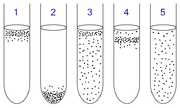
Microaerophile
Encyclopedia

Microorganism
A microorganism or microbe is a microscopic organism that comprises either a single cell , cell clusters, or no cell at all...
that requires oxygen
Oxygen
Oxygen is the element with atomic number 8 and represented by the symbol O. Its name derives from the Greek roots ὀξύς and -γενής , because at the time of naming, it was mistakenly thought that all acids required oxygen in their composition...
to survive, but requires environments containing lower levels of oxygen than are present in the atmosphere
Earth's atmosphere
The atmosphere of Earth is a layer of gases surrounding the planet Earth that is retained by Earth's gravity. The atmosphere protects life on Earth by absorbing ultraviolet solar radiation, warming the surface through heat retention , and reducing temperature extremes between day and night...
(~20% concentration). Many microphiles are also capnophiles, as they require an elevated concentration of carbon dioxide. In the laboratory they can be easily cultivated in a candle jar. A candle jar is a container into which a lit candle is introduced before sealing the container's airtight lid. The candle's flame burns until extinguished by oxygen deprivation, which creates a carbon dioxide-rich, oxygen-poor atmosphere in the jar.
Examples
Examples include:- Borrelia burgdorferiBorrelia burgdorferiBorrelia burgdorferi is a species of Gram negative bacteria of the spirochete class of the genus Borrelia. B. burgdorferi is predominant in North America, but also exists in Europe, and is the agent of Lyme disease....
, a species of spirochaeteSpirochaeteSpirochaetes belong to a phylum of distinctive Gram-negative bacteria, which have long, helically coiled cells...
bacteria that causes Lyme diseaseLyme diseaseLyme disease, or Lyme borreliosis, is an emerging infectious disease caused by at least three species of bacteria belonging to the genus Borrelia. Borrelia burgdorferi sensu stricto is the main cause of Lyme disease in the United States, whereas Borrelia afzelii and Borrelia garinii cause most...
in humans. - Helicobacter pyloriHelicobacter pyloriHelicobacter pylori , previously named Campylobacter pyloridis, is a Gram-negative, microaerophilic bacterium found in the stomach. It was identified in 1982 by Barry Marshall and Robin Warren, who found that it was present in patients with chronic gastritis and gastric ulcers, conditions that were...
, a species of proteobacteriaProteobacteriaThe Proteobacteria are a major group of bacteria. They include a wide variety of pathogens, such as Escherichia, Salmonella, Vibrio, Helicobacter, and many other notable genera....
that has been linked to peptic ulcerPeptic ulcerA peptic ulcer, also known as PUD or peptic ulcer disease, is the most common ulcer of an area of the gastrointestinal tract that is usually acidic and thus extremely painful. It is defined as mucosal erosions equal to or greater than 0.5 cm...
s and some types of gastritisGastritisGastritis is an inflammation of the lining of the stomach, and has many possible causes. The main acute causes are excessive alcohol consumption or prolonged use of nonsteroidal anti-inflammatory drugs such as aspirin or ibuprofen. Sometimes gastritis develops after major surgery, traumatic...
. Some don't consider it a true obligate microaerophile. - CampylobacterCampylobacterCampylobacter is a genus of bacteria that are Gram-negative, spiral, and microaerophilic. Motile, with either unipolar or bipolar flagella, the organisms have a characteristic spiral/corkscrew appearance and are oxidase-positive. Campylobacter jejuni is now recognized as one of the main causes...
has been described as microaerophilic. - Streptococcus intermediusStreptococcus intermediusStreptococcus intermedius is a commensal bacterium and a member of the Streptococcus anginosus group. The S. anginosus group, occasionally termed “Streptococcus milleri group” display hemolytic and serologic diversity, yet share core physiological traits. Despite being commensal organisms, members...
has also been described as microaerophilic. - Streptococcus pyogenesStreptococcus pyogenesStreptococcus pyogenes is a spherical, Gram-positive bacterium that is the cause of group A streptococcal infections. S. pyogenes displays streptococcal group A antigen on its cell wall. S...
, a well known microaerophile that causes streptococcal pharyngitis.
See also
- Aerotolerant organism
- Aerobic organismAerobic organismAn aerobic organism or aerobe is an organism that can survive and grow in an oxygenated environment.Faculitative anaerobes grow and survive in an oxygenated environment and so do aerotolerant anaerobes.-Glucose:...
- Anaerobic organismAnaerobic organismAn anaerobic organism or anaerobe is any organism that does not require oxygen for growth. It could possibly react negatively and may even die if oxygen is present...
- Facultative anaerobic organismFacultative anaerobic organismA facultative anaerobic organism is an organism, usually a bacterium, that makes ATP by aerobic respiration if oxygen is present but is also capable of switching to fermentation...
- Fermentation (biochemistry)Fermentation (biochemistry)Fermentation is the process of extracting energy from the oxidation of organic compounds, such as carbohydrates, using an endogenous electron acceptor, which is usually an organic compound. In contrast, respiration is where electrons are donated to an exogenous electron acceptor, such as oxygen,...

